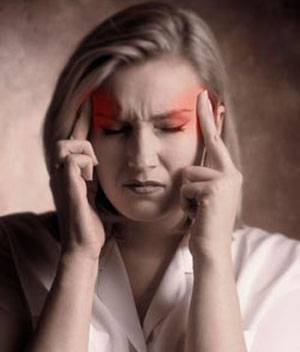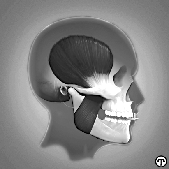First, four quick facts:
 Muscle
spasm pain due to occlusal interference (an unstable bite) is among the most
common causes of head, neck and facial pain.
Muscle
spasm pain due to occlusal interference (an unstable bite) is among the most
common causes of head, neck and facial pain.
Pain symptoms from occlusal interference are frequently confused with tension
headaches, migraine headaches, whiplash injuries and general head, neck and
facial pain.
According to a study published in the Academy and General Dentistry Journal,
100% of 100 consecutively examined new patients were found to have one or more
manifestations of biomechanical dental disease.
Nearly as many people damage their teeth as a result of biomechanical dental
disease as do from bacterial induced dental disease.
If you think this could apply to you, you are not alone. This applies to more
than half of the 80 million Americans who suffer from everything from mild and
annoying tension-type headaches to severe and debilitating migraines.
Medical experts say one of the most common causes of head, neck and facial
pain is a long-term conflict between the biting surfaces of the teeth and the
jaw joints, commonly known as TMJ dysfunction or occlusal interference. The
problem is caused by a slight misalignment of the teeth that causes the jaw
joint to be pulled out of the socket during biting and swallowing. This can
cause painful muscle fatigue and spasms leading to headaches, neck pain and
general facial pain.
Now, a veteran dental practitioner has come up with a possible solution. Dr.
Jerry Simon, D.D.S., spent many years researching occlusal interference, what
many consider the most fundamental but overlooked issue in dentistry today. As a
result, he developed a small plastic device, the Best-Bite™ Discluder, that both
assists dentists in determining whether a patient’s pain is bite-related as well
as provides short-term pain relief during the treatment process.
“Many headaches cannot be diagnosed by standard medical tests such as MRIs,
CAT scans and blood tests, so the diagnosis is often made on the symptoms
reported by the patient, leading to an incorrect diagnosis, and therefore
incorrect treatment, by the doctors,” explains Dr. Simon.
Patients bite down on the Discluder. It instantly assists the jaw joints in
stabilizing so the muscles no longer strain, the spasm is released and the pain
stops, generally in under two minutes. This helps the dentist determine if
occlusal interference is the root of the patient’s problem and devise a
successful drug- free treatment plan. The time savings benefits both dentist and
patient.
Symptoms of jaw misalignment include:
Any head, neck, or facial pain
Popping, clicking, ringing or grinding sounds in your jaw or ears.
A sore jaw in the morning or during chewing.
Pain from a whiplash injury that fails to go away
 Once
the problem has been diagnosed, the pain can often be stopped very quickly if
the interference’s are eliminated. If the meshing of the teeth is at fault,
careful grinding down of the offending area may achieve the required result For
instance the cusps and grooves on the upper back teeth should fit snugly into
the corresponding depressions and peaks on the biting surfaces of the back teeth
in the lower jaw.
Once
the problem has been diagnosed, the pain can often be stopped very quickly if
the interference’s are eliminated. If the meshing of the teeth is at fault,
careful grinding down of the offending area may achieve the required result For
instance the cusps and grooves on the upper back teeth should fit snugly into
the corresponding depressions and peaks on the biting surfaces of the back teeth
in the lower jaw.
If this snug fit does not exist, the dentist may attempt to reshape these
cusps to correct the bite.
To do this, the dentist may first take impressions of the upper and lower
jaws and make models of the teeth. These models are then mounted in a mechanical
device, called an articulator that simulates the movement of the patients jaw.
By studying the models in this way the dentist is able to determine where and
how much reshaping should take place.
For many patients, it is necessary for the dentist to make a small plastic
appliance, called an occlussal splint, which fits over the biting surfaces of
the upper teeth. The appliance is usually worn at night. The occlusal splint has
the effect of separating biting surfaces of the upper and lower jaw, thereby
allowing the chewing muscles to relax. Once these relax the pain usually
disappears. By eliminating night grinding in bruxers, the occlusal splint also
helps maintain the integrity of the teeth.